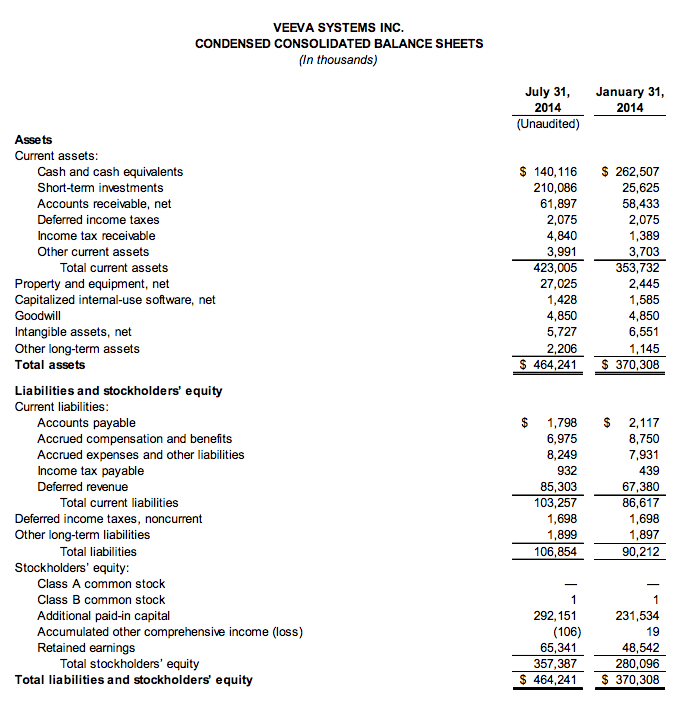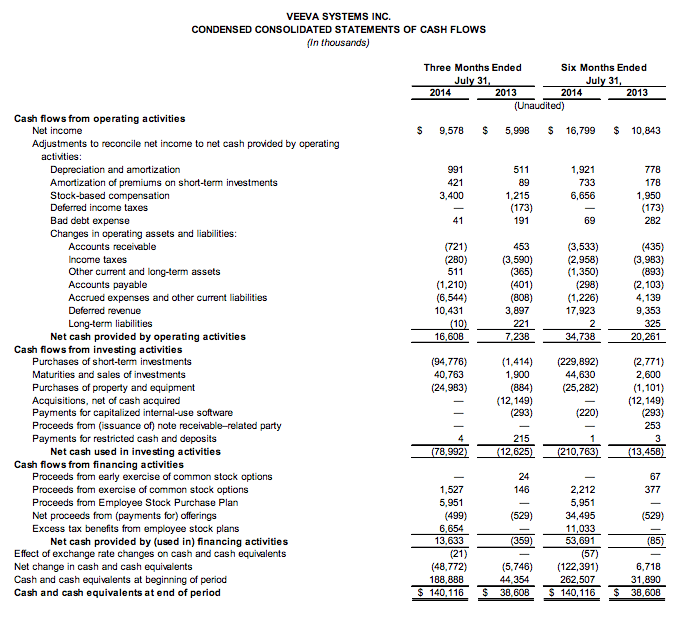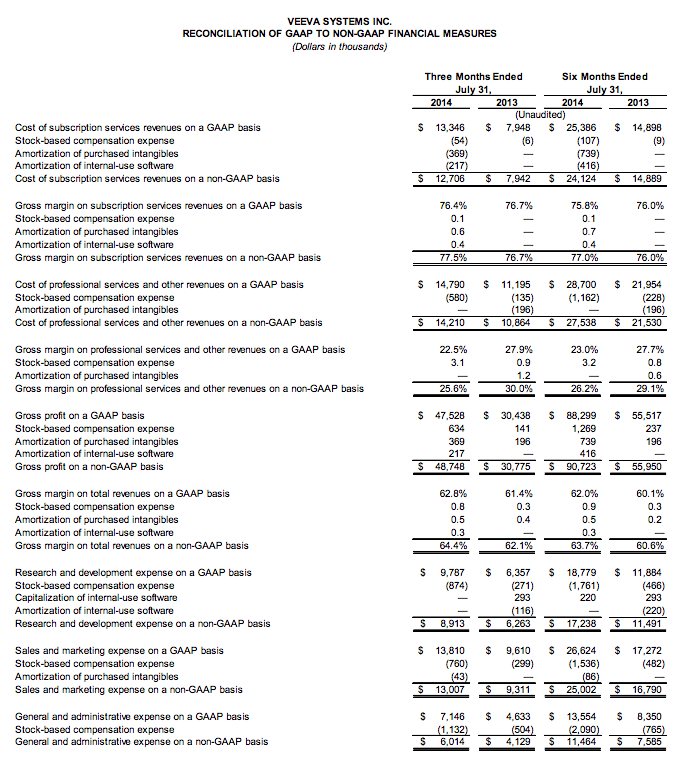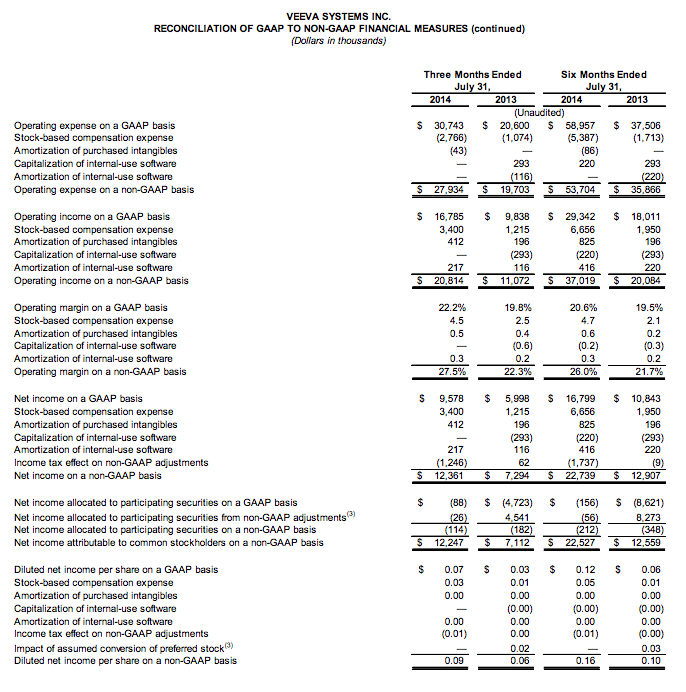Veeva Announces Fiscal 2015 Second Quarter Results
Total Revenues of $75.7M, up 53% Year-over-year;
Subscription Services Revenue of $56.6M, up 66% Year-over-year
PLEASANTON, CA — August 28, 2014 – Veeva Systems Inc. (NYSE: VEEV), a leading provider of industry cloud solutions for life sciences, today announced results for its fiscal second quarter ended July 31, 2014.
“Veeva’s commitment to the customer provides us with a considerable strategic advantage and is fueling our growth,” said CEO Peter Gassner. “With a foundation of customer success and innovative solutions that deliver measurable impact and significant time to value, we are well positioned for the tremendous industry cloud opportunity that lies ahead.”
Fiscal 2015 Second Quarter Results:
- Revenues: Total revenues for the second quarter were $75.7 million, up from $49.6 million one year ago, an increase of 53% year-over-year. Subscription services revenues for the second quarter were $56.6 million, up from $34.1 million one year ago, an increase of 66% year-over-year.
- Operating income and non-GAAP operating income(1): Second quarter operating income was $16.8 million, compared to $9.8 million one year ago, an increase of 71% year-over-year. Non-GAAP operating income for the second quarter was $20.8 million, compared to $11.1 million one year ago, an increase of 88% year-over-year.
- Net income and non-GAAP net income(1): Second quarter net income was $9.6 million, compared to$6.0 million one year ago, an increase of 60% year-over-year. Non-GAAP net income for the second quarter was $12.4 million, compared to $7.3 million one year ago, an increase of 69% year-over-year.
- Net income per share and non-GAAP net income per share(1): For the second quarter, fully diluted net income per share was $0.07, while non-GAAP fully diluted net income per share was $0.09.
"Our financial results were exceptional this quarter and we're seeing continued momentum in the business," said CFO Tim Cabral. "Therefore, we are raising our annual revenues guidance by over $20 million and expect to cross the $300 million mark in total revenues this fiscal year."
Recent Highlights:
- Moving the Industry to Multichannel CRM – In the quarter, Veeva saw particular strength with Veeva CRM deployments globally, added 10 new Veeva CRM Approved Email customers, and signed its first customer to Veeva CRM Engage, Veeva's cloud-based online detailing platform.
- Momentum in Veeva Vault – Veeva made great progress with Veeva Vault, a next-generation regulated content management solution, adding more than 10 new customers in the quarter, including the second Top 10 pharma customer for Vault eTMF, Veeva’s solution for the management of clinical trial content.
- Veeva Network Goes Global – Veeva delivered the first single-instance global customer master solution with Veeva Network Version 3. This new global capability generated strong interest and prompted some early customers to expand their use of Network across multiple countries.
Financial Outlook:
Veeva is providing guidance for its fiscal third quarter ending October 31, 2014 as follows:
- Total revenues between $78 and $79 million.
- Non-GAAP operating income between $19 and $20 million.
- Non-GAAP fully diluted net income per share of $0.08.
Veeva is updating guidance for its fiscal year ending January 31, 2015 as follows:
- Total revenues between $300 and $303 million, versus our prior guidance of $277 to $282 million.
- Non-GAAP operating income between $73 and $76 million, versus our prior guidance of $58 to $63 million.
- Non-GAAP fully diluted net income per share between $0.30 and $0.31, versus our prior guidance of $0.26 to $0.28.
Conference Call Information
What: Veeva’s Fiscal 2015 Second Quarter Results Conference Call
When: Thursday, August 28, 2014
Time: 1:30 p.m. PT (4:30 p.m. ET)
Live Call: 1-877-201-0168, domestic 1-647-788-4901, international Conference ID 8534 8607
Webcast: ir.veeva.com
(1) This press release uses non-GAAP financial metrics that are adjusted for the impact of various GAAP items. See the sections titled “Non-GAAP Financial Measures” and the tables entitled “Reconciliation of GAAP to Non-GAAP Financial Measures” below for details.
About Veeva Systems
Veeva Systems Inc. is a leader in cloud-based software for the global life sciences industry. Committed to innovation, product excellence, and customer success, Veeva has more than 200 customers, ranging from the world's largest pharmaceutical companies to emerging biotechs. Veeva is headquartered in the San Francisco Bay Area, with offices in Europe, Asia, and Latin America. For more information, visit www.veeva.com.
Forward-looking Statements
This release contains forward-looking statements, including statements regarding the market opportunity in industry cloud, Veeva's future financial outlook and financial performance, market growth, the benefits from the use of Veeva's solutions, our strategies, and general business conditions. Any forward-looking statements contained in this press release are based upon Veeva's historical performance and its current plans, estimates and expectations and are not a representation that such plans, estimates, or expectations will be achieved. These forward-looking statements represent Veeva's expectations as of the date of this press announcement. Subsequent events may cause these expectations to change, and Veeva disclaims any obligation to update the forward-looking statements in the future. These forward-looking statements are subject to known and unknown risks and uncertainties that may cause actual results to differ materially, including (i) adverse changes in general economic or market conditions, particularly in the life sciences industry; (ii) delays or reductions in information technology spending, particularly in the life sciences industry, including as a result of mergers in the life sciences industry; (iii) dependence on revenues from our Veeva CRM solution, and the rate of adoption of our new products; (iv) competitive factors, including but not limited to pricing pressures, industry consolidation, entry of new competitors and new applications and marketing initiatives by our competitors; (v) our ability to manage our growth effectively; (vi) our limited operating history, which makes it difficult to predict future results; (vii) the development of the market for enterprise cloud services, particularly in the life sciences industry; (viii) acceptance of our applications and services by customers, including renewals of existing subscriptions and purchases of subscriptions for additional users and solutions; (ix) breaches in our security measures, unauthorized access to our customers’ data, or system availability or performance problems associated with our data centers or computing infrastructure; (x) our expectation that the future growth rate of our revenues will decline, and that as our costs increase, we may not be able to generate sufficient revenues to sustain the level of profitability we have achieved in the past or achieve profitability in the future; (xi) loss of one or more key customers; and (xii) changes in sales that may not be immediately reflected in our results due to our subscription model.
Additional risks and uncertainties that could affect Veeva’s financial results are included under the captions “Risk Factors” and “Management’s Discussion and Analysis of Financial Condition and Results of Operations,” in the company’s filing on Form 10-Q for the period ended April 30, 2014, which is available on the company’s website at www.veeva.com under the Investors section and on the SEC’s website at www.sec.gov. Further information on potential risks that could affect actual results will be included in other filings Veeva makes with the SEC from time to time.
Non-GAAP Financial Measures
Veeva has provided in this release financial information that has not been prepared in accordance with generally accepted accounting principles in the United States, or GAAP. This information includes non-GAAP net income, non-GAAP fully diluted net income per share, non-GAAP operating income, and non-GAAP operating margin. Veeva uses these non-GAAP financial measures internally for budgeting and resource allocation purposes and in analyzing its financial results. Veeva believes they are useful to investors, as a supplement to GAAP measures, as a means to evaluate period-to-period comparisons, in evaluating Veeva's ongoing operating results and trends and in comparing its financial measures with other companies in Veeva's industry, many of which present similar non-GAAP financial measures to investors. These non-GAAP measures are adjusted for the impact of expenses associated with stock-based compensation, amortization of purchased intangibles, capitalization of expenses associated with development of internal-use software and the subsequent amortization of the capitalized expenses, and the tax effect of all of these non-GAAP adjustments.
As described above, Veeva may exclude the following items from its non-GAAP measures:
- Stock-based compensation expenses. Veeva excludes stock-based compensation expenses from its non-GAAP measures primarily because they are non-cash expenses and management finds it useful to exclude certain non-cash charges to assess the appropriate level of various operating expenses to assist in budgeting, planning and forecasting future periods. Moreover, because of varying available valuation methodologies, subjective assumptions and the variety of award types that companies can use under FASB ASC Topic 718, Veeva believes excluding stock-based compensation expenses allows investors to make meaningful comparisons between our recurring core business operating results and those of other companies.
- Amortization of purchased intangibles. Veeva incurs amortization of acquisition-related purchased intangible assets in connection with acquisitions of certain businesses and technologies. Amortization of intangible assets is inconsistent in amount and frequency and is significantly affected by the timing and size of acquisitions. Management finds it useful to exclude these variable charges to assess the appropriate level of various operating expenses to assist in budgeting, planning and forecasting future periods. Investors should note that the use of intangible assets contributed to our revenues earned during the periods presented and will contribute to our future period revenues as well. Amortization of purchased intangible assets will recur in future periods.
- Capitalization of internal-use software development expenses and the subsequent amortization of the capitalized expenses. Veeva capitalizes certain costs incurred for the development of computer software for internal use and then amortizes those costs over the estimated useful life. Capitalization and amortization of software development costs can vary significantly depending on the timing of products reaching technological feasibility and being made generally available. Moreover, because of the variety of approaches taken and the subjective assumptions made by other companies in this area, Veeva believes that excluding the effects of capitalized software costs allows investors to make more meaningful comparisons between our operating results and those of other companies.
- Income tax effects on the difference between GAAP and non-GAAP costs and expenses. The income tax effects that are excluded from the non-GAAP measures relate to the tax impact on the difference between GAAP and non-GAAP costs and expenses due to stock-based compensation, purchased intangibles and capitalized internal-use software for GAAP and non-GAAP measures.
There are limitations in using non-GAAP financial measures because non-GAAP financial measures are not prepared in accordance with GAAP and may be different from non-GAAP financial measures used by other companies. The non-GAAP financial measures are limited in value because they exclude certain items that may have a material impact upon our reported financial results. In addition, they are subject to inherent limitations as they reflect the exercise of judgments by management about which items are adjusted to calculate our non-GAAP financial measures. Veeva compensates for these limitations by analyzing current and future results on a GAAP basis as well as a non-GAAP basis and also by providing GAAP measures in our public disclosures.
Non-GAAP financial measures should not be considered in isolation from, or as a substitute for, financial information prepared in accordance with GAAP. Investors are encouraged to review the reconciliation of these non-GAAP measures to their most directly comparable GAAP financial measure and not to rely on any single financial measure to evaluate our business. A reconciliation of GAAP to the non-GAAP financial measures has been provided in the tables below.
Veeva is not able, at this time, to provide GAAP targets for operating income and operating margin and fully diluted net income per share for its fiscal third quarter ending October 31, 2014 or its fiscal year ending January 31, 2015 because of the difficulty of estimating certain items that are excluded from non-GAAP operating margin and non-GAAP fully diluted net income per share, such as charges related to stock-based compensation expense, capitalization of internal-use software development expenses and the subsequent amortization of the capitalized expenses and amortization of acquisition related intangibles, the effect of which may be significant.
The following table reconciles the specific items excluded from GAAP net income in the calculation of non-GAAP net income and non-GAAP net income per share for the periods shown below:
(3) In computing the net income attributed to common stockholders for the three and six months ended July 31, 2013 for non-GAAP purposes, the net income allocated to participating securities was adjusted for the convertible preferred stock that was assumed to be converted to common shares. In computing the fully diluted shares for the three and six months ended July 31, 2013 for non-GAAP purposes, the 85,000,000 shares of convertible preferred stock that was issued and outstanding as of July 31, 2013 were assumed to be converted to common shares.




